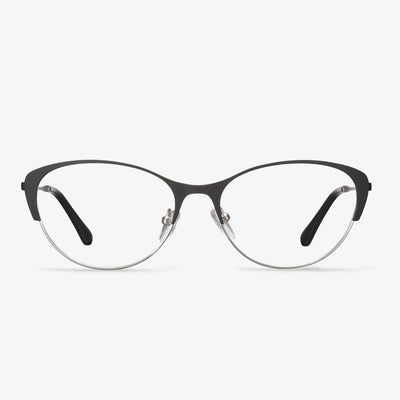What Are Trifocal Lenses?
When you are over 40 years old, your eyes may become old, too. Your corrective lens requirements may become increasingly unique, Most people are familiar with bifocal glasses but unfamiliar with trifocal glasses. So, in this post, we will show you what trifocal glasses are.
Trifocal lenses have three different corrective lenses within one lens to offer you intermediate, distance, and near correction, all in one pair of glasses. The varying levels of correction cab are laid out in a couple of different ways to ensure the layout suits your unique vision needs and comfort level.
The near vision is to correct close-up vision, the intermediate vision is often used for card playing and staring at the computer screen fall with this range of vision, and the distance vision is often used for driving or looking at a whiteboard.
What Are Rimless Glasses?
A right pair of glasses enhance your appearance as well as your vision. If you choose a pair of unsuitable glasses, they can weigh down your face and hide delicate your features. So, more and more would like to choose the right pair of glasses and many people like rimless glasses.
What are rimless glasses? From the name, you can know the meaning. It means that there are no frames on glasses. Rimless glasses can help ease eyewear apprehension by improving your vision without overhauling your look.
In addition, rimless glasses are light weight and comfortable. Because they accent your natural beauty, your features won’t get buried under a pair of rimless glasses.
Of course, there are some advantages and disadvantages of frameless glasses. So, in the following section, we will list.
Transition Lenses Problems
It is not convenient to rely on photochromic lenses when driving. It also may be unsafe if the driver depends on the prescription to see or is legally bound to wear prescription lenses when driving.
Besides, transition lenses are typically the size and shape of regular vision-correction lenses, which allows them to accurately correct the field of vision, but does not account for peripheral areas on either side of the visible range. Sunglasses operate by maintaining very dark glasses that expand over the field of vision and the peripheral with large, oblong lenses that block sunlight from both the front and sides. However, transition lenses are not typically dark enough for heavy sun and cannot block light penetration on the peripheral, leading to people having to resort to sunglasses again.
Of course, there are some benefits of transition lenses and you can click here to learn more.
What Is Anti Reflective Coating?
Anti reflective coating, also known as AR, anti-glare, no-glare, or glare-free coating, can provide benefits to your vision. Anti reflective coating is added to lenses to reduce glare caused by light hitting the back of the lenses to improve your vision and make your eyeglasses more visually attractive.
Anti reflective coating will eliminate all reflections from the front and back surfaces of your lenses. Hence, more light is able to pass through your lenses which improves your vision. At the same time, fewer distractions are visible and the lenses are hardly noticeable, especially in the dark. So, is anti glare worth it? Most people agree that.
What progressive spectacle lenses are best?
Essilor is a brand, and it designs, manufactures, and markets a wide range of lens products to help people correct and protect their vision. Essilor adheres to the corporate mission of 'improving vision, improving life', invests 200 million euros in research and development every year, and constantly launches new products to enhance consumers' experience in wearing glasses. Continuous innovation has always been the core gene of Essilor. In 1959, Essilor created the resin lens, and in the same year, it invented the world's first progressive lens. Innovation involves technology, manufacturing, sales, and service. Based on innovation, they can make as many people as possible obtain visual health, and this is the driving force to promote their development.
The discoloration principle of photochromic lenses
The fine grains of silver halide and copper oxide were melted into the glass melt of the lens blank material to produce the lens. When the lens is in the ultraviolet environment, the silver halide molecules will undergo a chemical reaction due to the ultraviolet radiation and decompose into silver ion particles and halogens. Because the silver particles are dark and absorb visible light, the lens gets darker. When the ultraviolet light is weakened or isolated, silver ions and halogens are recombined under the action of catalyst copper oxide to form silver halide, so the color of the lens gradually becomes lighter and transparent again. The discoloration mechanism of the resin lens is similar to that of the glass lens.
Why do so many people like rimless glasses?
Rimless glasses are lighter because they have no frame and are made of memory titanium alloy, which greatly relieves the pressure on the bridge of the nose and eyes and makes them more comfortable to wear. And because there are no frames to tie them down, the wearer has a wider view. Rimless glasses style is more diverse and stylish. They are rich in color, so loved by young eyeglasses.











































